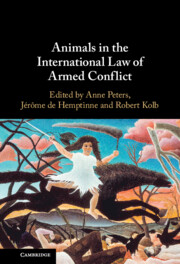Book contents
- Animals in the International Law of Armed Conflict
- Animals in the International Law of Armed Conflict
- Copyright page
- Contents
- Contributors
- Forewords
- Acknowledgements
- Abbreviations
- Part I The Need for Protecting Animals in Wartime
- Part II The Protection of Animals in International and Non-international Armed Conflicts
- Part III The Protection of Animals in Specific Situations
- 13 Animals in Occupied Territory
- 14 Animals in Protected Zones
- 15 Animals in Sea Warfare
- 16 Animals in Disaster Situations
- 17 Animals as Means of Military Experimentation
- Part IV Enforcement Regimes for the Protection of Animals in Wartime
- Part V Towards Better Protection of Animals in Wartime
- Index
- References
13 - Animals in Occupied Territory
from Part III - The Protection of Animals in Specific Situations
Published online by Cambridge University Press: 06 October 2022
- Animals in the International Law of Armed Conflict
- Animals in the International Law of Armed Conflict
- Copyright page
- Contents
- Contributors
- Forewords
- Acknowledgements
- Abbreviations
- Part I The Need for Protecting Animals in Wartime
- Part II The Protection of Animals in International and Non-international Armed Conflicts
- Part III The Protection of Animals in Specific Situations
- 13 Animals in Occupied Territory
- 14 Animals in Protected Zones
- 15 Animals in Sea Warfare
- 16 Animals in Disaster Situations
- 17 Animals as Means of Military Experimentation
- Part IV Enforcement Regimes for the Protection of Animals in Wartime
- Part V Towards Better Protection of Animals in Wartime
- Index
- References
Summary
This chapter explores the international legal protection offered to animals in occupied territory. Some rules of international humanitarian law protecting private and public property apply to animals as well. The legal framework is complemented by the domestic law in force prior to the occupation, and by international conventions on animal conservation that remain applicable during armed conflict. Nonetheless, animals in occupied territory are insufficiently protected. In order to strengthen legal protection, occupying powers should properly fulfil their duty to observe and apply local legislation such as animal welfare statutes. A non-anthropocentric approach based on animals’ needs, rather than on animals as property or as parts of the environment, would help to enhance the protection of animals in occupied territory.
Keywords
- Type
- Chapter
- Information
- Animals in the International Law of Armed Conflict , pp. 217 - 233Publisher: Cambridge University PressPrint publication year: 2022
References
Select Bibliography
- 1
- Cited by

